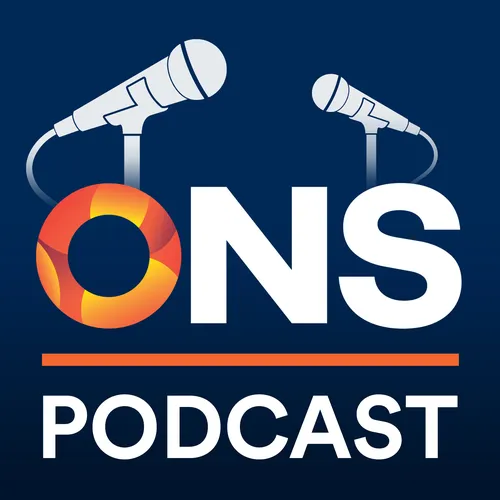
The ONS Podcast
Where ONS Voices Talk Cancer
Join oncology nurses on the Oncology Nursing Society's award-winning podcast as they sit down to discuss the topics important to nursing practice and treating patients with cancer.
ISSN 2998-2308
- Update frequency
- every 7 days
- Average duration
- 34 minutes
- Episodes
- 383
- Years Active
- 2017 - 2025

Episode 240: Spirituality in Cancer Care
“When we are able to connect with the things that give us meaning in our life, it makes us stronger, it makes us happier, it makes our life more fulfilled,” Caroline Peacock, ACPE certified educator,…

Episode 239: Meet the ONS Board of Directors: Allen, Mathey, and Robison
What is it like to guide a professional association that serves more than 100,000 oncology nurses? ONS Directors-at-Large Deborah “Hutch” Allen, PhD, RN, CNS, FNP-BC, AOCNP®, Kris Mathey, MS, APRN-CN…

Episode 238: Cancer Genomics for Every Oncology Nurse
“Genomics is part and parcel of oncology treatment today. Even if a patient’s genomics might not affect the current choice of therapy, it may do so in the future. The use of genomics and biomarkers i…

Episode 237: Oncologic Emergencies 101: Prepare Your Practice With Clear Policies and Procedures
“These policies, procedures, order sets, and algorithms for oncologic emergencies are so important. They give you knowledge in your back pocket: This is the way we’re going to treat this, this is the…

Episode 236: Coping With Grief
“Acknowledge that grief is a reoccurring theme. This isn’t something that’s a one and done. This is a process that you’re going to continue to revisit, and in recognizing that, I think this allows us…

Episode 235: Self-Advocacy Skills for Patients
“Effective communication with healthcare providers, making informed decisions about their care, and gaining strength through connections to others” are the key aspects of patient self-advocacy, ONS m…

Episode 234: Oncologic Emergencies 101: Thrombotic Thrombocytopenia Purpura
“Once patients come out on the other side, nursing care involves understanding how to triage their disease: If they call you with concerns, how would you address those concerns? How would you find ou…

Episode 233: Staying Current During Constant Change
“Participating in formal academic degree programs, obtaining contact hours for renewing your certification, peer-to-peer sharing with colleagues—they’re all types of education that you can use to be …

Episode 232: Managing Fatigue During PARP Inhibitor Maintenance Therapy
“For those without cancer or other illnesses, we often have a resolution or relief of this fatigue. ‘Oh, I’m just going to go to bed early and get a couple more hours of sleep tonight.’ Or ‘I’m going…

Episode 231: Nurses Thrive in a Healthy Work Culture
“Work culture is really how people work together. But in my opinion, there are three major components: it’s the employer, it’s the leadership, and it’s the staff—all staff, we’re not only talking nur…

Episode 230: Violence in Health Care
“A lot of healthcare workers that I talk to say that they are kind of brought up with the culture that violence is part of the job. It’s not your job to take abuse,” Chris Snyder, University of Utah …

Episode 229: How Advocacy Can Shape Your Nursing Career
“Oftentimes, local policy changes are the ones that are going to influence your day-to-day practice most directly—and are the ones where your voice has the most power because you’re closer to the dec…

Episode 228: Oncologic Emergencies 101: Disseminated Intravascular Coagulation
“Consider your patient’s diagnosis. What kind of cancer do they have? And ask yourself, ‘Could this patient be in disseminated intravascular coagulation (DIC)? Is there something more that we should …

Episode 227: Biomarker Testing, PARP Inhibitors, and Oral Adherence During Ovarian Cancer Maintenance Therapy
“We found that nurses still needed clarity of terminology and the rationale for germline, somatic, and homologous recombination deficiency testing,” ONS member Paula Anastasia, MN, RN, AOCN®, clinica…

Episode 226: Patient Education for Next-Generation Sequencing to Guide Cancer Therapy
“Nurses can bridge the information gap and help patients better understand that the information received from next-generation sequencing (NGS) can really help to determine which treatment they will r…

Episode 225: Central Line Dressing Changes: Get It Right the First Time
“Really knowing these steps can save our own nursing time and save our patient’s skin from all the dressing removals. If we’re not doing these dressings as much, we’re all going to be happier,” MiKae…

Episode 224: Meet the ONS Board of Directors: Nevidjon, Geddie, and Garner
What is it like to guide a professional association that serves more than 100,000 oncology nurses? ONS Chief Executive Officer Brenda Nevidjon, MSN, RN, FAAN, and Directors-at-Large Patricia (Patty) …

Episode 223: Oncologic Emergencies 101: Superior Vena Cava Syndrome
“I think that we as nurses need to advocate when a patient is uncomfortable. And it’s not your classic ‘pain in my hip’ kind of thing. This is a more subtle, ‘I can’t breathe, I have a sense of impen…

Episode 222: Ethical and Moral Dilemmas of Futility in Cancer Care and Treatment
“Let’s take time, invest time, in learning more about futility. Let’s invest some time in learning more about how to understand our patient’s goals, their family’s goals, what their values are,” Kath…

Episode 221: Surgical Interventions for Patients With Cancer
“Our goal in surgical oncology is, of course, to treat the cancer for a cure, but to do it in a safe manner so the patient is able to recover and resume their normal living activities that they had b…